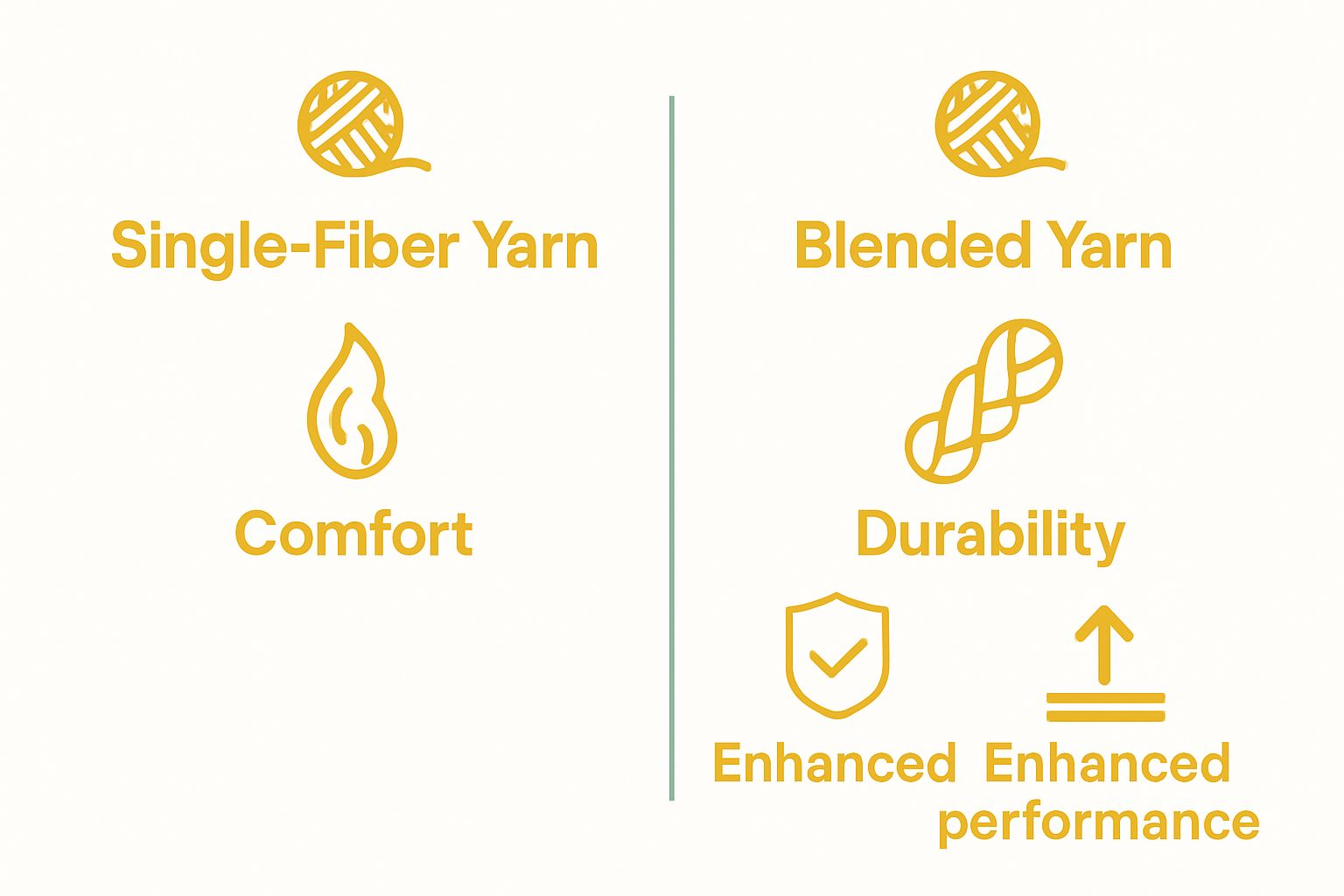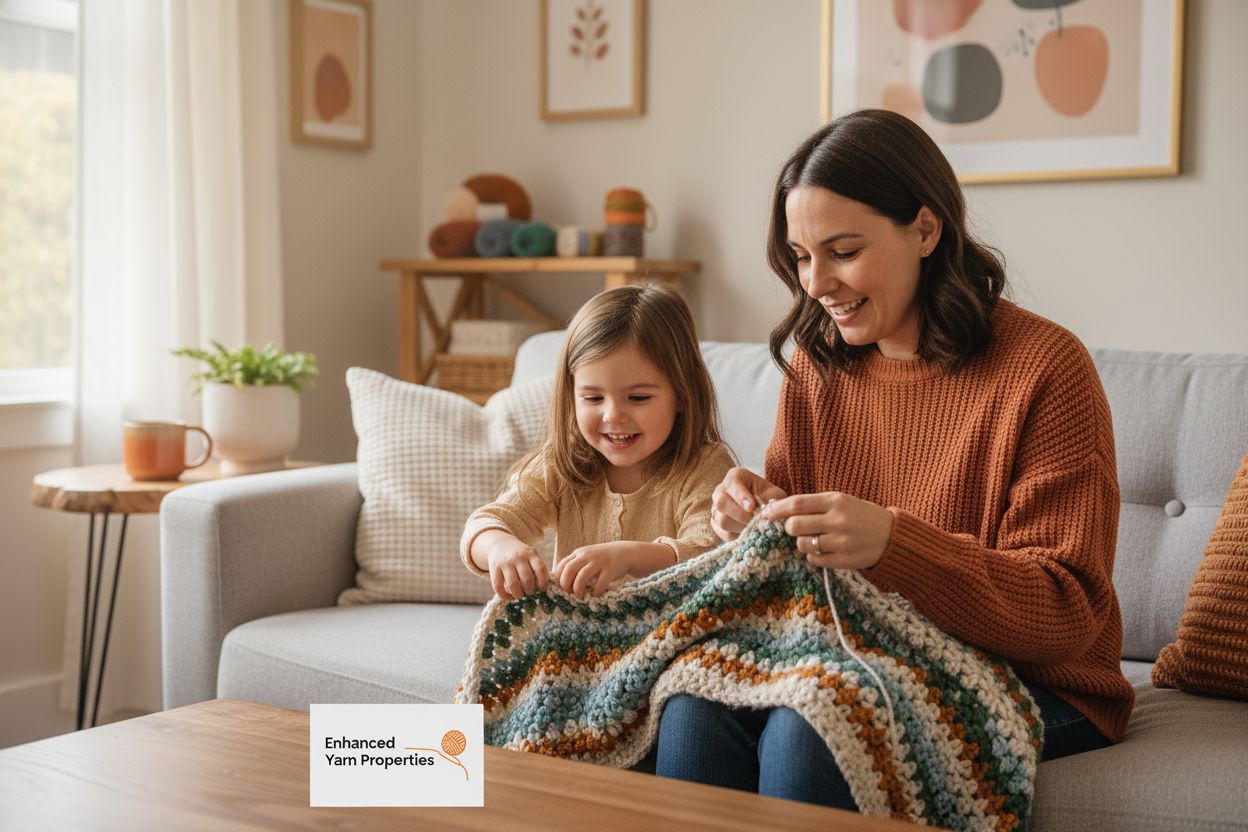
Understanding the Role of Blended Yarns in Crafting
Blended yarns are popping up everywhere in the crafting world for one big reason. Some blends combine natural and synthetic fibers to create yarn that is up to 40 percent more durable than traditional single-fiber options. This may sound like just another clever manufacturing trick. But what actually happens inside these yarns rewrites the rules for both what you can make and how your finished project will feel.
Table of Contents
- What Are Blended Yarns And How Are They Made?
- Why Blended Yarns Matter In Knitting And Crocheting
- How Blended Yarns Enhance Yarn Properties
- The Versatility Of Blended Yarns In Creative Projects
Quick Summary
| Takeaway | Explanation |
|---|---|
| Blended yarns enhance performance | Combining fibers improves durability, elasticity, and moisture management, creating superior yarns for various projects. |
| Specific fiber blends achieve unique properties | Different combinations allow crafters to target qualities like warmth, strength, and texture for their creations. |
| Precision in manufacturing is essential | A meticulous process ensures consistent quality and performance in the final blended yarn product. |
| Aesthetic versatility opens design possibilities | Blended yarns enable diverse colors and textures, allowing crafters to explore creative design options. |
| Optimize yarn selection for each project | Choosing the right blend for specific uses can significantly enhance project outcomes and user experience. |
What are Blended Yarns and How are They Made?
Blended yarns represent a sophisticated textile innovation where multiple fiber types are strategically combined to create superior yarn with enhanced performance characteristics. Textile manufacturing experts define blended yarns as composite materials created by intentionally mixing two or more different fiber types during the spinning process.
Fiber Composition and Selection
The role of blended yarns in crafting extends far beyond simple material combination. Crafters select specific fiber blends to achieve desired outcomes such as:
- Improved durability
- Enhanced comfort
- Specialized texture
- Balanced performance characteristics
Typical fiber combinations might include wool with synthetic materials, cotton with polyester, or natural fibers with engineered performance threads. Each blend introduces unique properties that transform the yarn’s fundamental characteristics.
Below is a table summarizing common blended yarn fiber combinations and the unique properties each blend brings to crafting projects.
| Fiber Blend | Key Properties | Example Crafting Use |
|---|---|---|
| Wool + Synthetic Fiber | Durable, warm, elastic | Winter scarves, outdoor garments |
| Cotton + Polyester | Breathable, wrinkle-resistant, durable | Everyday clothing, accessories |
| Natural + Engineered Fiber | Specialized performance (e.g., moisture wicking, UV) | Sportswear, performance gear |
| Merino Wool + Synthetic | Lightweight, moisture-resistant, warm | Lightweight winter accessories |
| Cotton + Rayon | Softness, drape, sheen | Baby blankets, soft garments |
Manufacturing Process
The creation of blended yarns involves precise mechanical and chemical processes. Manufacturers begin by carefully measuring and mixing different staple fibers in predetermined ratios. These fibers undergo several critical stages:
- Blending: Initial mixing of selected fibers
- Carding: Aligning and cleaning fiber strands
- Drawing: Stretching and refining fiber mixture
- Spinning: Transforming fiber blend into continuous yarn
This meticulous approach ensures uniform distribution and consistent performance across the entire yarn strand. The final product represents a harmonious integration of different fiber characteristics, offering crafters unprecedented versatility.
This table outlines the different stages involved in the manufacturing process of blended yarns and explains the purpose of each stage.
| Manufacturing Stage | Purpose |
|---|---|
| Blending | Mix selected fibers uniformly |
| Carding | Align and clean fiber strands |
| Drawing | Stretch and refine fiber mixture |
| Spinning | Transform fiber blend into continuous yarn |
For crafters seeking further details on specialized yarn types, understanding blended yarn manufacturing provides crucial insights into material selection and project planning.
Why Blended Yarns Matter in Knitting and Crocheting
Textile research demonstrates that blended yarns have revolutionized crafting by offering unprecedented versatility and performance. Crafters increasingly recognize that these innovative materials provide solutions to traditional limitations in yarn selection, enabling more sophisticated and refined textile creations.
Performance Enhancement
Blended yarns deliver superior performance characteristics that single-fiber yarns cannot match. Durability and functional properties become dramatically improved through strategic fiber combinations. Crafters can now create projects with:
- Greater resistance to wear and tear
- Improved moisture management
- Enhanced thermal regulation
- Reduced likelihood of fiber breakdown
For instance, combining wool with synthetic fibers creates a yarn that maintains wool’s warmth while introducing synthetic strength and elasticity. This approach transforms traditional crafting limitations into opportunities for innovation.
Aesthetic and Functional Diversity
Beyond performance, blended yarns offer remarkable aesthetic possibilities. Different fiber combinations can produce unique visual and tactile experiences that elevate crafting projects. Color retention, texture variation, and drape quality become controllable design elements.
Knitters and crocheters can now select yarns that precisely match their project requirements, whether seeking softness for baby garments, durability for outdoor wear, or specialized textures for artistic expressions.
Explore more about understanding yarn characteristics to make informed crafting decisions.
The strategic use of blended yarns represents a sophisticated approach to textile creation, where technical engineering meets creative expression.
How Blended Yarns Enhance Yarn Properties
Scientific research reveals that blended yarns represent a sophisticated approach to manipulating fiber characteristics, allowing crafters to create materials with enhanced performance beyond traditional single-fiber limitations. By strategically combining different fibers, manufacturers can engineer yarns with complex and targeted properties.
Structural and Performance Modifications
Blended yarns fundamentally transform yarn properties through precise fiber interactions. The integration of different fibers creates a synergistic effect where each component contributes unique strengths. Key property enhancements include:
- Increased tensile strength
- Improved elasticity
- Enhanced moisture management
- Better thermal regulation
- Superior abrasion resistance
For example, combining cotton with polyester can produce a yarn that retains cotton’s breathability while adding polyester’s durability and wrinkle resistance.
 This approach allows crafters to customize yarn characteristics for specific project requirements.
This approach allows crafters to customize yarn characteristics for specific project requirements.
Functional Property Optimization
Beyond basic structural improvements, blended yarns enable advanced functional modifications. Specialized fiber combinations can introduce remarkable capabilities such as:
- Antimicrobial properties
- UV protection
- Temperature adaptation
- Rapid moisture wicking
Crafters seeking versatile materials can now select yarns with complex performance profiles that adapt to diverse environmental conditions. Learn more about selecting lightweight yarns to understand how specific fiber blends create targeted performance outcomes.
The scientific precision behind blended yarn development transforms textile crafting from a traditional art into a sophisticated, engineered practice.
The Versatility of Blended Yarns in Creative Projects
Textile design research highlights how blended yarns have transformed creative crafting by offering unprecedented flexibility in material selection. These innovative yarns provide crafters with a dynamic palette of opportunities to explore complex design possibilities across multiple project types.
Project-Specific Performance Optimization
Blended yarns enable crafters to select materials precisely tailored to specific project requirements. Strategic fiber combinations allow for nuanced performance characteristics that traditional single-fiber yarns cannot achieve:
- Garments requiring temperature regulation
- Accessories needing enhanced durability
- Decorative items demanding unique textures
- Functional pieces with specialized performance needs
For instance, a winter scarf blending merino wool with synthetic fibers can provide warmth, lightweight comfort, and resistance to moisture absorption. This approach transforms crafting from a purely aesthetic practice to a sophisticated material engineering process.
Creative Design Exploration
Beyond functional considerations, blended yarns dramatically expand creative design potential. Aesthetic versatility becomes a key advantage, allowing crafters to experiment with:
- Complex color interactions
- Varied texture combinations
- Innovative surface effects
- Unique drape and movement characteristics
Discover essential yarn fiber types to understand the foundational elements that make these creative explorations possible. Blended yarns represent more than just a material choice they are a creative medium that bridges traditional craft techniques with contemporary design innovation.

Elevate Your Crafting With the Perfect Blended Yarn
If you struggle to find yarns that truly match your project’s needs for durability, comfort, and creative flexibility, you are not alone. Many crafters face challenges when choosing materials that offer the ideal mix of strength and artistry. The article explained how blended yarns solve common crafting problems by combining fibers for better performance, richer textures, and enhanced results. Ready to turn your creative vision into reality?
.png)
Browse the wide selection of blended and specialty yarns at CRAFTISS. Discover fibers engineered for improved wear, balanced warmth, and unique textures. Visit CRAFTISS.com to access expert tips and everything you need for inspired knitting and crochet, all in one place. Take the next step and unlock new possibilities for your next project. Shop now to experience the difference that high-quality blended yarns can make.
Frequently Asked Questions
What are the benefits of using blended yarns in crafting?
Blended yarns provide improved durability, enhanced comfort, and specialized textures that single-fiber yarns often lack. To leverage these benefits, consider selecting blends that match your project’s specific requirements for both performance and appearance.
How do I choose the right fiber combination for my project with blended yarns?
Identify the desired qualities for your project, such as moisture management or warmth. Then, experiment with common blends like cotton with polyester or wool with synthetic fibers to find the combination that best suits your needs.
Can blended yarns improve the lifespan of my knitted or crocheted items?
Yes, blended yarns typically enhance durability and resistance to wear, thereby potentially extending the life of your crafted items. Evaluate the fiber characteristics before starting your project to ensure they meet your durability requirements.
How do I care for items made from blended yarns?
Care for blended yarn items by following the specific washing and drying instructions for each fiber type in the blend. Regularly check your items for wear and wash them according to the most delicate fiber to ensure longevity.
What are some creative project ideas for using blended yarns?
Consider using blended yarns for a variety of projects, such as winter scarves combining warmth and moisture resistance, or baby hats that require softness and comfort. Explore different fiber combinations to enhance both function and aesthetics in your creations.
How can I understand the characteristics of blended yarns better?
Familiarize yourself with the performance and aesthetic properties that each fiber type brings to a blend. To deepen your knowledge, experiment with different yarns in small projects to see firsthand how they behave and perform.


